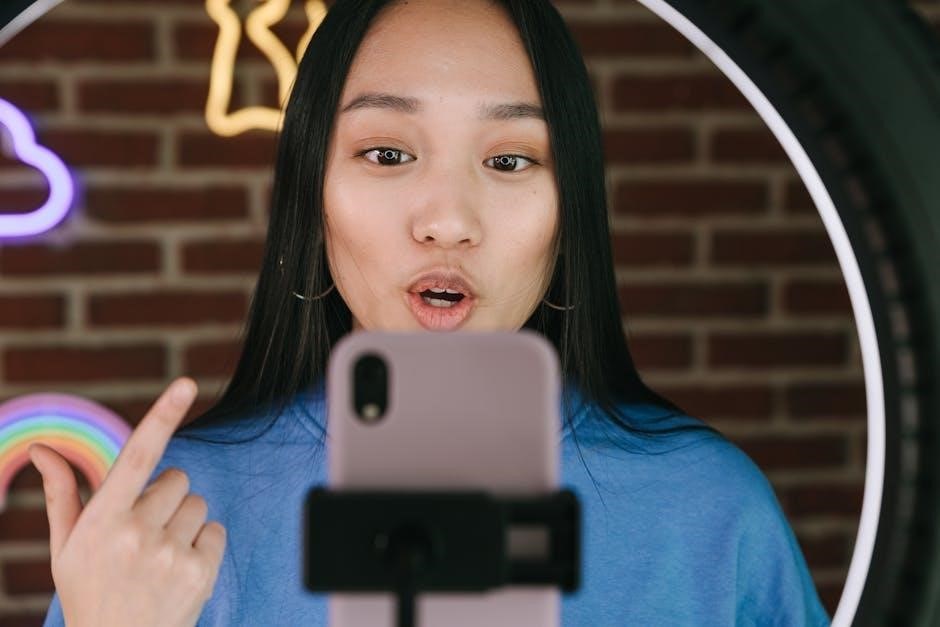Social influencer marketing has emerged as a powerful tool for brands to connect with audiences through trusted voices‚ leveraging authenticity and reach to drive engagement and sales effectively.
The Evolution of Social Media Marketing
Social media marketing has undergone significant transformation since its inception. Initially‚ platforms like Facebook and Instagram focused on connecting individuals‚ but brands soon recognized their potential for reaching audiences. Early strategies emphasized organic growth through engaging content‚ while paid advertising emerged as a dominant force. The rise of influencers marked a pivotal shift‚ enabling brands to leverage trusted voices for credibility. Data analytics became crucial‚ allowing precise targeting and performance measurement. Today‚ social media marketing integrates multimedia content‚ AI-driven insights‚ and interactive experiences‚ reflecting a dynamic‚ consumer-centric approach. This evolution underscores the adaptability of brands in harnessing digital platforms to foster meaningful connections and drive business growth.
The Role of Influencers in Modern Marketing
Influencers have become integral to modern marketing strategies‚ serving as bridges between brands and consumers. By fostering trust and credibility‚ they amplify brand messages effectively. Their ability to engage niche audiences ensures targeted reach‚ enhancing campaign effectiveness. Influencers create authentic content that resonates personally with followers‚ driving conversions and brand loyalty. As marketing evolves‚ their role continues to expand‚ making them indispensable in today’s digital landscape.
Understanding the Social Influencer Formula
The social influencer formula combines reach‚ engagement‚ and credibility to create impactful campaigns‚ leveraging trust and authenticity to connect brands with their target audiences effectively online.
Defining a Social Influencer
A social influencer is an individual who has built a significant following on social media platforms‚ leveraging their expertise‚ authenticity‚ and relatability to impact their audience’s purchasing decisions. They often focus on specific niches‚ such as fashion‚ fitness‚ or technology‚ where they establish credibility. Influencers can range from micro-influencers with highly engaged smaller audiences to macro-influencers with massive followings. Their ability to connect personally with their audience allows them to promote products or services in a way that feels organic and trustworthy‚ making them valuable partners for brands seeking to reach targeted demographics effectively. By fostering trust and engagement‚ social influencers have become integral to modern marketing strategies‚ bridging the gap between brands and consumers in a digital age.
The Psychology Behind Influencer Marketing
The psychology behind influencer marketing revolves around trust‚ social proof‚ and emotional connection. Audiences often view influencers as relatable figures who share similar experiences‚ creating a bond that fosters credibility. This trust is amplified when influencers endorse products they genuinely use‚ making their recommendations feel authentic and personalized. Social proof‚ a key psychological principle‚ plays a significant role as consumers are more likely to adopt behaviors or purchase products endorsed by others they admire; Additionally‚ the fear of missing out (FOMO) and the desire to align with societal trends drive engagement. Influencers tap into these psychological triggers‚ leveraging their authority to influence purchasing decisions. By understanding these dynamics‚ brands can craft campaigns that resonate deeply with their target audience‚ enhancing the effectiveness of their marketing efforts and fostering lasting consumer loyalty. This interplay of trust‚ relatability‚ and psychological principles forms the backbone of successful influencer marketing strategies.
How Influencers Build Trust and Credibility

Influencers establish trust and credibility by consistently delivering authentic and valuable content that aligns with their audience’s interests and needs; Transparency is key‚ as followers appreciate when influencers openly disclose sponsored content or affiliations. Building expertise in a specific niche further solidifies their authority‚ making their recommendations more reliable. Engagement with the audience‚ through comments‚ direct messages‚ and interactive content‚ fosters a sense of connection and trust. Additionally‚ influencers often share personal experiences and testimonials‚ showcasing real-world applications of products or services. Over time‚ this consistent and genuine approach creates a loyal community that trusts their opinions. Ethical practices‚ such as promoting products they believe in‚ also enhance their credibility. By maintaining authenticity and transparency‚ influencers build a foundation of trust that is essential for their influence and the success of their marketing efforts.

The Core Components of the Social Influencer Formula
The core components of the social influencer formula include identifying target audiences‚ creating engaging content‚ measuring engagement‚ and optimizing for conversions to ensure campaign success.

Identifying Your Target Audience
Identifying the target audience is crucial for effective influencer marketing. It involves analyzing demographics‚ interests‚ and behaviors to ensure alignment with the brand’s goals. By understanding the audience’s preferences‚ brands can select influencers who resonate with them‚ leading to higher engagement and conversion rates. Tools like social media analytics and audience segmentation help in creating detailed profiles‚ ensuring campaigns reach the right people. This step is fundamental for maximizing ROI and building meaningful connections with potential customers.
Content Creation Strategies for Maximum Engagement
Creating engaging content is vital for capturing the audience’s attention and fostering meaningful interactions. Brands should focus on authenticity‚ ensuring content aligns with the influencer’s voice and resonates with their audience. High-quality visuals‚ compelling captions‚ and storytelling techniques can significantly enhance engagement. Diversifying content formats‚ such as videos‚ blog posts‚ and social media stories‚ caters to different audience preferences. Encouraging audience participation through comments‚ polls‚ or Q&A sessions fosters a sense of community. Consistency in posting schedules helps maintain audience interest and builds trust. Leveraging trending topics and hashtags can increase visibility‚ while collaborating with influencers ensures content is tailored to their audience’s needs. By implementing these strategies‚ brands can create content that drives engagement and fosters lasting connections with their target audience.
Leveraging Engagement Metrics for Success
Engagement metrics are crucial for measuring the effectiveness of influencer marketing campaigns. Key metrics include engagement rate‚ likes‚ comments‚ shares‚ and saves‚ which indicate audience interaction and content resonance. Tracking these metrics helps brands understand what drives audience participation and what may need improvement. Tools like Instagram Insights and Google Analytics provide detailed data to assess performance. High engagement rates often correlate with authentic content and strong influencer-audience connections. By analyzing these metrics‚ brands can identify top-performing content types and refine their strategies accordingly. A/B testing different content formats can further optimize engagement. Monitoring follower growth rate and click-through rates also provides insights into campaign success. Ultimately‚ leveraging engagement metrics allows brands to make data-driven decisions‚ enhancing the impact of their influencer marketing efforts and ensuring a strong return on investment.

Conversion Optimization Techniques
Conversion optimization is a critical component of influencer marketing‚ focusing on turning audience engagement into actionable results. Brands achieve this by implementing strategies like clear call-to-action (CTA) buttons‚ such as “Shop Now” or “Sign Up Today‚” which guide followers toward specific actions. Landing pages tailored to the influencer’s audience can also boost conversions by providing a seamless user experience. A/B testing different CTAs‚ visuals‚ or messaging helps identify what resonates best with the target audience. Additionally‚ using analytics tools to track click-through rates and conversion rates allows brands to refine their strategies. Influencers often collaborate with brands to create compelling content that aligns with their audience’s preferences‚ further enhancing conversion potential. By continuously testing and optimizing these elements‚ brands can maximize their return on investment and achieve their marketing goals effectively.

Tools and Platforms for Influencer Marketing
Influencer marketing relies on platforms like AspireIQ‚ Upfluence‚ and Grin for influencer discovery‚ content creation tools like Canva‚ and analytics tools like Hootsuite for performance tracking to optimize campaigns.
Influencer Marketing Platforms
Influencer marketing platforms are essential tools that connect brands with influencers‚ streamlining collaboration and campaign management. Popular platforms like AspireIQ‚ Upfluence‚ and Grin offer extensive influencer databases‚ allowing brands to filter by niche‚ audience size‚ and engagement rates. These platforms also provide tools for outreach‚ contract management‚ and campaign tracking‚ ensuring seamless communication and performance monitoring. Additionally‚ some platforms integrate content creation and SEO optimization features‚ helping brands maximize their influencer partnerships. By leveraging these platforms‚ businesses can efficiently identify‚ collaborate with‚ and measure the impact of influencers‚ making influencer marketing more accessible and scalable across industries. They play a critical role in automating and enhancing the effectiveness of influencer marketing strategies‚ enabling brands to achieve their goals more efficiently.
Content Creation Tools
Content creation tools are indispensable for influencers and brands aiming to produce high-quality‚ engaging material. Platforms like Canva and Adobe Creative Cloud offer design templates and editing features‚ enabling the creation of visually appealing graphics‚ videos‚ and social media posts. Tools like Final Cut Pro and DaVinci Resolve cater to video editing needs‚ while Unsplash and Shutterstock provide stock images for authentic visuals. SEO tools such as Yoast and SEMrush help optimize content for better search engine rankings. Additionally‚ scheduling tools like Hootsuite and Buffer streamline content distribution across multiple platforms. These tools empower influencers to craft compelling narratives‚ ensuring their content resonates with target audiences and aligns with brand objectives. By leveraging these resources‚ creators can efficiently produce‚ manage‚ and deliver content that drives engagement and fosters meaningful connections with their audience.
Analytics and Performance Tracking Software
Analytics and performance tracking software are essential for measuring the success of influencer marketing campaigns; Tools like Google Analytics and Instagram Insights provide detailed metrics on engagement rates‚ website traffic‚ and conversion rates‚ helping brands assess campaign effectiveness. Platforms such as Hootsuite and Sprout Social offer comprehensive dashboards to monitor social media performance‚ track hashtag campaigns‚ and analyze audience demographics. SEMrush and Ahrefs are useful for SEO optimization‚ identifying trends‚ and competitor analysis. These tools enable brands to refine their strategies based on data-driven insights‚ ensuring maximum ROI. By leveraging these analytics platforms‚ influencers and marketers can identify what resonates with their audience‚ optimize content‚ and measure the tangible impact of their efforts. This data is crucial for proving the value of influencer marketing and informing future campaign decisions.

Case Studies and Real-World Applications
Real-world applications of the social influencer formula include successful campaigns by brands like Nike and Adidas‚ leveraging influencers for authentic storytelling and community-building efforts.

Successful Influencer Marketing Campaigns
Successful influencer marketing campaigns often hinge on authenticity and strategic partnerships. For instance‚ brands like Nike and Adidas have effectively collaborated with influencers to amplify their reach. Nike’s “Find Your Greatness” campaign leveraged micro-influencers to share personal fitness journeys‚ creating relatable content that resonated globally. Similarly‚ Adidas partnered with sports influencers to promote their footwear‚ blending storytelling with product showcases. These campaigns thrived by aligning brand values with influencer audiences‚ fostering trust and engagement; They also utilized user-generated content to build credibility‚ encouraging followers to share their experiences. By focusing on niche audiences and delivering consistent messaging‚ these campaigns achieved measurable success‚ including increased brand awareness and sales growth. Such examples highlight the power of influencers in driving authentic connections and measurable results for brands. These strategies remain central to the social influencer formula‚ proving its effectiveness in modern marketing.
Lessons Learned from Failed Campaigns
Failed influencer marketing campaigns often highlight critical lessons for brands. One common issue is misaligned partnerships‚ where influencers’ values or audiences don’t match the brand‚ leading to disconnected messaging. For instance‚ campaigns lacking authenticity‚ such as influencers promoting products they don’t genuinely endorse‚ often fail to resonate with audiences. Another pitfall is overreliance on follower counts without considering engagement rates‚ which can result in low ROI. Additionally‚ campaigns without clear objectives or tracking metrics often struggle to measure success. Brands must also avoid over-scripted content that feels inauthentic to the influencer’s voice. Lessons from these failures emphasize the importance of thorough audience research‚ aligning with influencers who genuinely connect with the brand‚ and setting measurable KPIs. By addressing these pitfalls‚ brands can refine their strategies to achieve better outcomes in future campaigns.

The Future of Social Influencer Marketing
The future of social influencer marketing lies in AI integration‚ virtual influencers‚ and niche markets‚ enabling brands to target audiences with precision and authenticity‚ driving innovation in engagement strategies.
Emerging Trends in Influencer Marketing
Emerging trends in influencer marketing highlight a shift toward micro-influencers‚ who offer higher engagement rates and niche audience connections. Brands are increasingly prioritizing authenticity and long-term partnerships over one-time collaborations. Sustainability is also becoming a key focus‚ with influencers and brands aligning on eco-friendly initiatives. Additionally‚ interactive content formats like virtual events and shoppable posts are gaining traction‚ enabling seamless customer journeys. The rise of AI-driven analytics is helping brands optimize campaigns by predicting influencer performance and audience preferences. Lastly‚ the integration of global influencer networks is allowing brands to reach diverse audiences‚ fostering cross-cultural marketing strategies. These trends underscore the evolving nature of influencer marketing‚ emphasizing innovation‚ personalization‚ and ethical practices to enhance campaign effectiveness and consumer trust.
The Impact of AI on Influencer Marketing
AI is revolutionizing influencer marketing by enhancing efficiency‚ personalization‚ and scalability. AI algorithms analyze vast datasets to identify optimal influencers for brands‚ ensuring alignment with target audiences. Machine learning predicts influencer performance and audience preferences‚ enabling smarter campaign decisions. AI-driven tools automate content creation‚ suggesting captions‚ hashtags‚ and visuals to maximize engagement. Chatbots streamline communication between brands and influencers‚ reducing manual effort. Additionally‚ AI-powered analytics provide real-time insights into campaign effectiveness‚ helping brands refine strategies. AI also aids in fraud detection‚ identifying fake followers and ensuring authentic engagement. As AI evolves‚ it empowers brands to scale influencer marketing efforts globally‚ reaching diverse audiences with tailored messages. Ultimately‚ AI transforms influencer marketing into a data-driven‚ efficient‚ and highly personalized field‚ driving measurable results for businesses worldwide.
The Rise of Niche Influencers
Niche influencers are gaining prominence by focusing on specific‚ often specialized areas‚ catering to dedicated audiences. Unlike macro-influencers‚ they emphasize depth over breadth‚ fostering strong connections with highly engaged followers. Brands are increasingly valuing niche influencers for their authenticity and expertise‚ which resonate deeply with target audiences. This shift reflects a demand for more personalized and relatable content‚ as niche influencers often have unparalleled knowledge in their domains. Their ability to drive conversions through trusted recommendations makes them indispensable in targeted marketing strategies. However‚ brands must balance the benefits of niche influencers with challenges like limited reach and scalability. As the influencer landscape evolves‚ niche voices are becoming critical for brands seeking authentic‚ tailored campaigns that resonate with specific communities‚ proving that specialization can be a powerful driver of engagement and loyalty in the digital age.
Social influencer marketing effectively connects brands with audiences through authentic voices‚ fostering engagement and sales. To succeed‚ brands must prioritize authenticity‚ targeted content‚ and continuous optimization in their strategies.
Summarizing the Social Influencer Formula

The social influencer formula combines identifying target audiences‚ creating engaging content‚ and leveraging analytics to maximize reach and conversions. It emphasizes building trust through authenticity and consistency‚ ensuring long-term brand partnerships and customer loyalty. By focusing on niche markets and utilizing advanced tools‚ influencers optimize their strategies to align with brand goals‚ driving measurable results and fostering meaningful connections with their audiences.
How to Implement the Formula for Your Brand
Implementing the social influencer formula begins with defining clear brand goals and identifying the right influencers who align with your target audience and values. Authenticity is key‚ so collaborate with influencers who genuinely resonate with your brand. Develop a content strategy that encourages engagement and storytelling‚ ensuring it aligns with your marketing objectives. Monitor performance using analytics tools to track engagement‚ conversions‚ and ROI. Optimize campaigns by refining content and adjusting strategies based on data insights. Building long-term relationships with influencers fosters trust and consistency‚ enhancing your brand’s credibility. Lastly‚ stay adaptable to industry trends and continuously refine your approach to maintain relevance and maximize impact in the ever-evolving landscape of social media.

